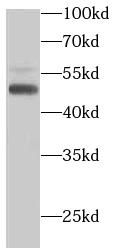Products
PTEN antibody
- SPECIFICATIONS
- CITATIONS
- Product Name
- PTEN antibody
- Catalogue No.
- FNab06912
- Size
- 100μg
- Form
- liquid
- Purification
- Protein A+G purification
- Purity
- ≥95% as determined by SDS-PAGE
- Clonality
- monoclonal
- Isotype
- IgG1
- Clone ID
- 9E6
- Storage
- PBS with 0.02% sodium azide and 50% glycerol pH 7.3, -20℃ for 12 months(Avoid repeated freeze / thaw cycles.)
Immunogen
- Immunogen
- phosphatase and tensin homolog
- Alternative Names
- MMAC1 antibody, TEP1 antibody
- UniProt ID
- P60484
- Observed MW
- 47 kDa
Application
- Tested Applications
- ELISA, IHC, WB, IF
- Recommended dilution
- WB: 1:1000-1:4000; IHC: 1:200-1:1000; IF: 1:20-1:200
Validated Images
 DU 145 cells were subjected to SDS PAGE followed by western blot with FNab06912(PTEN Antibody) at dilution of 1:2000
DU 145 cells were subjected to SDS PAGE followed by western blot with FNab06912(PTEN Antibody) at dilution of 1:2000
 Immunohistochemistry of paraffin-embedded human lung cancer tissue slide using FNab06912(PTEN Antibody) at dilution of 1:500
Immunohistochemistry of paraffin-embedded human lung cancer tissue slide using FNab06912(PTEN Antibody) at dilution of 1:500
 Immunofluorescent analysis of HepG2 cells using FNab06912 (PTEN antibody) at dilution of 1:50 and Alexa Fluor 488-conjugated Goat Anti-Mouse IgG(H+L)
Immunofluorescent analysis of HepG2 cells using FNab06912 (PTEN antibody) at dilution of 1:50 and Alexa Fluor 488-conjugated Goat Anti-Mouse IgG(H+L)
- Background
- This gene was identified as a tumor suppressor that is mutated in a large number of cancers at high frequency. The protein encoded by this gene is a phosphatidylinositol-3,4,5-trisphosphate 3-phosphatase. It contains a tensin like domain as well as a catalytic domain similar to that of the dual specificity protein tyrosine phosphatases. Unlike most of the protein tyrosine phosphatases, this protein preferentially dephosphorylates phosphoinositide substrates. It negatively regulates intracellular levels of phosphatidylinositol-3,4,5-trisphosphate in cells and functions as a tumor suppressor by negatively regulating AKT/PKB signaling pathway. The use of a non-canonical (CUG) upstream initiation site produces a longer isoform that initiates translation with a leucine, and is thought to be preferentially associated with the mitochondrial inner membrane. This longer isoform may help regulate energy metabolism in the mitochondria. A pseudogene of this gene is found on chromosome 9. Alternative splicing and the use of multiple translation start codons results in multiple transcript variants encoding different isoforms.
IF: 1.851
- Journal:
- Molecular Medicine Reports
- Cited Date:
- 2019-12-17
- Product:



